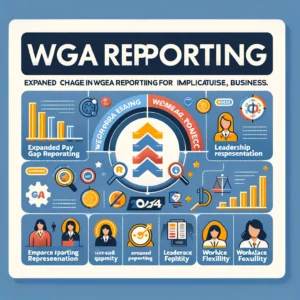Understanding the Changes

The WGEA has introduced several key changes aimed at enhancing the transparency and effectiveness of gender equality reporting. These adjustments are designed to provide a more comprehensive view of gender equality within Australian workplaces, focusing on areas such as pay equity, leadership representation, and workplace flexibility. Among these changes, the most significant include:
- Expanded Pay Gap Reporting: Businesses are now required to report more granular data on pay gaps, including bonuses and other performance-based payments.
- Greater Detail on Leadership Representation: There is a deeper focus on the gender composition of leadership roles within organisations, aiming to identify and address the glass ceiling effect.
- Enhanced Reporting on Workplace Flexibility: Companies must provide detailed information on their workplace flexibility policies and how they are applied to support gender equality.
Implications for Your Business

The revised WGEA reporting requirements signal a shift towards greater accountability and transparency. For businesses, these changes have several implications:
- Increased Data Collection and Analysis Efforts: Organisations will need to invest more resources in data collection and analysis to meet the new reporting standards.
- Greater Scrutiny on Pay Equity: With a more detailed examination of pay gaps, businesses may need to reassess their compensation structures to address any disparities.
- Enhanced Focus on Leadership Diversity: Companies will be encouraged to develop more robust strategies for promoting gender diversity in leadership positions.
- Promotion of Workplace Flexibility: Demonstrating effective workplace flexibility practices will become crucial in showcasing a commitment to gender equality.
Navigating the Changes

To successfully navigate these changes, businesses can adopt several strategies:
- Leverage Technology: Utilising advanced HR and reporting software can simplify the process of collecting and analysing the required data.
- Review and Adjust Compensation Policies: Conduct regular audits of compensation practices to identify and address any gender pay gaps.
- Foster Leadership Diversity: Implement targeted leadership development programs and initiatives to promote gender diversity at all levels of management.
- Promote and Implement Flexible Working Arrangements: Develop clear policies on workplace flexibility and ensure they are accessible and applicable to all employees.
Key Takeaways
- Preparation is Key: Businesses should start preparing for the new reporting requirements by reviewing their current data collection and reporting processes.
- Technology is a Valuable Ally: Leveraging technology can greatly ease the burden of data collection and analysis, making it easier to comply with the new requirements.
- Focus on Pay Equity and Leadership Diversity: Addressing pay equity and promoting leadership diversity are critical to meeting the new reporting standards and advancing gender equality.
- Workplace Flexibility is Integral: Demonstrating effective workplace flexibility practices is essential in showcasing a commitment to gender equality.
The recent changes to WGEA reporting requirements underscore the importance of gender equality as a key component of corporate responsibility in Australia. By understanding these changes and their implications, businesses can not only comply with the new requirements but also take meaningful steps towards creating more equitable and inclusive workplaces.






